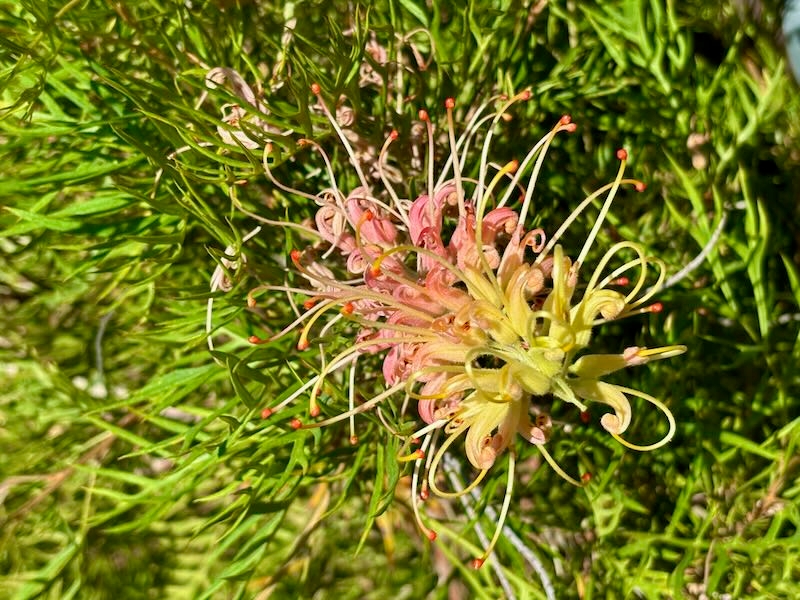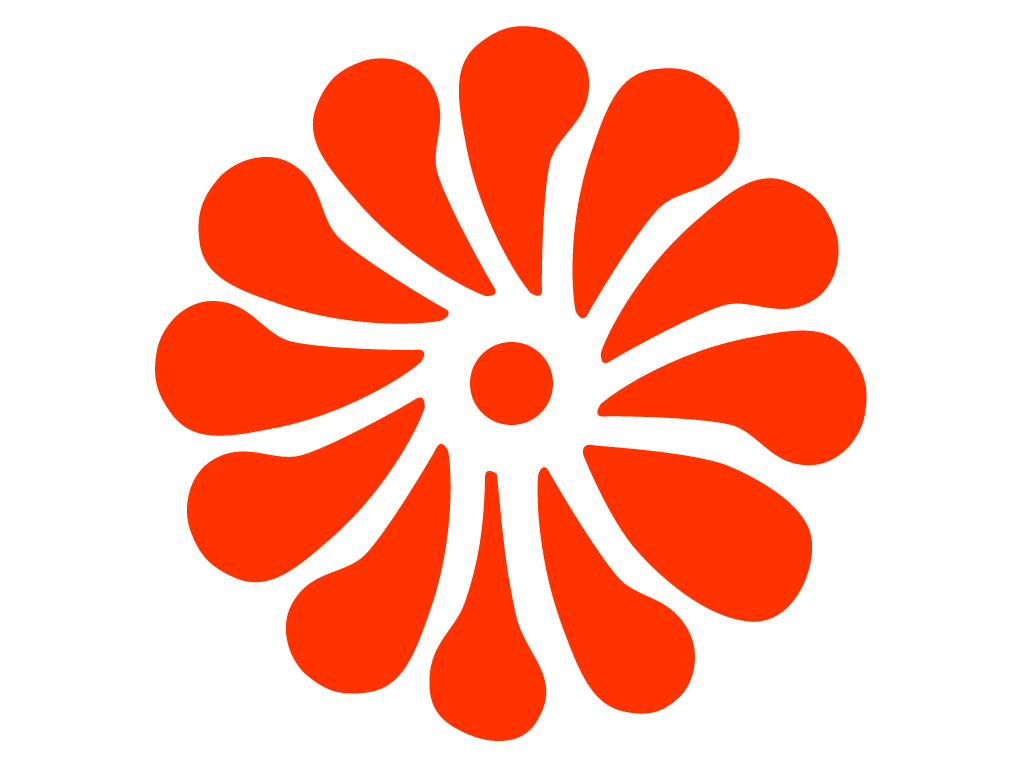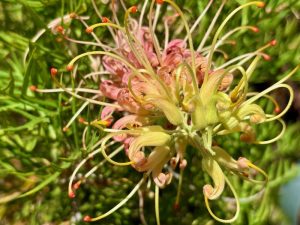Peach-Glow Powerhouse: Grow Grevillea ‘Peaches and Cream’ For Year-Round Color
Grevillea ‘Peaches and Cream‘ turns sunlight into nectar and bloom. This Australian hybrid in the Proteaceae family covers itself in soft yellow, peach, and apricot pincushions that roll in almost nonstop. Gardeners know it as Peaches And Cream Grevillea, Grevillea ‘Peaches & Cream’, and Hybrid Grevillea. Whatever tag you find at the nursery, you get the same winning traits: fine, deeply cut foliage, constant flowers that shift tone as they age, and a dense, screening habit. Plant it once in the right spot and it will look after itself with very little fuss.
Why Grevillea ‘Peaches and Cream’ earns a place in your garden
You want long color with low water once established. You also want movement and life. This shrub answers on both counts. The brushy, spider-like clusters drip nectar. Honeyeaters and other nectar-feeding birds in warm regions flock to it. In North America, hummingbirds claim it as a favorite. Beneficial insects visit too. At human distance, the blooms read as soft peach. Up close, they reveal threads of greenish yellow, butter, salmon, and warm apricot. Because the plant flowers heavily and often, you never wait long for a fresh flush.
Grevillea ‘Peaches and Cream’ size, habit, and look
Expect a broad, multi-stemmed evergreen shrub. In average garden conditions it reaches 1.5–2.4 m tall (5–8 ft) and spreads 2.4–3.6 m (8–12 ft). And, in lean, coastal soils it may sit closer to 1.2–1.8 m (4–6 ft) high and wide; in deeper loam with winter rain it can push the larger measurements. The foliage is bright green and finely divided, with narrow lobes that give a soft, fern-like texture. In winter the leaves can pick up bronze highlights, which adds seasonal depth.
Inflorescences measure about 10–15 cm long (4–6 in) and hold loosely coiled, toothbrush-style flowers. Buds open creamy green, then gain yellow, blush, and finally apricot to light orange. Because each cluster holds many individual florets at different stages, you see several colors at once. Stems carry the blooms at the branch tips where they catch light and pollinators.
Flowering season and color performance
This grevillea repeats all year in mild climates. Peak display usually arrives in spring and again in late summer into autumn. In Mediterranean zones with dry summers, it pauses only during extreme heat, then restarts with the first hint of cooler nights. In subtropical gardens with summer rain, it simply keeps going. Cold snaps can thin flowers, yet established plants rebound fast when weather settles. Color runs truest in full sun. In light shade, flowers hold but show a bit more yellow and a bit less apricot.
Grevillea ‘Peaches and Cream’ family, origin, and parentage
As a member of the Proteaceae, Grevillea sits with a remarkable group that includes proteas, banksias, and leucadendrons. ‘Peaches and Cream’ is a selected hybrid between Grevillea bipinnatifida and Grevillea banksii. The cross appeared as a spontaneous seedling in a Queensland garden in the late 1990s and went on to commercial release. The parentage matters for culture. From G. banksii it inherits vigor, sun hunger, and long bloom. From G. bipinnatifida it gains cold tolerance, compact branching, and refined foliage. The cultivar holds U.S. Plant Patent PP18,035, which helped drive accurate naming as it entered global trade.
Where to plant Grevillea ‘Peaches and Cream’
Use it as a low screen along a fence where you want privacy and flowers together. In coastal gardens, place it as a wind-filtering hedge that still lets light pass. On a slope, plant it in an open triangle pattern at 1.8–2.4 m (6–8 ft) centers and let the crowns knit for erosion control. In small urban yards, keep it pruned to 1.2–1.5 m (4–5 ft) as a glowing specimen across from a patio. The color plays well with silvers and blues. Try it with Westringia, dwarf Lomandra, blue chalk sticks (Senecio serpens), low Salvia, and native grasses. Against darker evergreens, its peach bracts pop.
How to Grow Grevillea ‘Peaches and Cream’
Set the conditions and the plant takes over. The guide below breaks each need into a quick, practical step so you can plant it and enjoy the show.
Light
Give it full sun for the strongest bloom and tightest habit. Aim for 6–8 hours of direct light daily. In very hot inland zones, light afternoon shade helps leaves keep their color. If you only have bright, open shade for part of the day, it will grow, but expect fewer flowers and a looser plant.
Soil
Choose a fast-draining, slightly acidic soil. An ideal mix blends sandy or loamy mineral soil with 20–30% coarse material such as decomposed granite or pine bark fines. Target pH 5.5–6.5. The roots resent heavy clay and winter-wet ground. If you garden on clay, build a broad, low mound 15–20 cm high (6–8 in) and 1–1.5 m wide (3–5 ft) and plant into that raised area. In containers, use a bark-based native or protea mix rather than peat-heavy potting soil.
Watering
You should water to establish, then water sparingly. For the first 6–10 weeks, keep the root zone evenly moist, not saturated. As a guide, supply 10–15 L (2.5–4 US gal) once or twice weekly in warm, dry weather, adjusting for your soil. Once you see vigorous new growth, switch to deep, infrequent irrigation. In the ground, a mature plant in summer may need only a thorough soak every 10–21 days in Mediterranean climates. But, in humid subtropics with summer rain, you may not need to irrigate at all. In containers, check moisture often; water when the top 5 cm (2 in) dries.
Fertilizing
Feed lightly and avoid phosphorus. Proteaceae roots absorb phosphorus very efficiently and can suffer toxicity if you apply standard fertilizers. At planting, blend a small dose of a native-safe, low-P controlled-release product into the backfill. During the growing season, top-dress with composted pine bark or leaf mold once in spring. If growth looks pale, apply a chelated iron and micronutrient tonic rather than a heavy N-P-K. In containers, use a native-formulated slow-release feed at half label rate every 4–6 months.
Temperature and hardiness
‘Peaches and Cream’ handles light frost. Expect foliage to cope down to about –4 °C (25 °F) once established. Young tips may scorch at colder dips, but the plant bounces back from live wood. In USDA Zones 9–11 it grows outdoors year-round. In colder regions, keep it in a large, free-draining container and protect it in an unheated but frost-free space during hard freezes. Heat is not a problem; dry summer air actually suits it.
Planting and spacing
Plant in autumn in Mediterranean climates or in spring where summers are wet. Dig a broad hole, twice as wide as the root ball and no deeper. Set the crown level with the surrounding soil or slightly high by 2–3 cm (¾–1¼ in). Backfill with your amended, fast-draining mix and water well to settle. Space multiple plants 1.8–3 m (6–10 ft) apart depending on the screen density you want. For a hedge at 1.5 m (5 ft) tall, set them at 1.5–1.8 m (5–6 ft) centers, then tip-prune to thicken.
Mulch
Mulch to moderate soil temperature and reduce weeds. Apply a 5–7 cm (2–3 in) layer of chipped hardwood, pine bark, or gravel. Keep mulch a few centimeters off the stem. In fire-prone areas, use gravel or decomposed granite rather than bark within the immediate plant base.
Container growing
Use a durable pot 40–50 cm (16–20 in) wide with large drainage holes. A squat, broad container resists wind and keeps the mix airy. Fill with a bark-based native mix cut with 20–30% coarse perlite or scoria. Water when the top 5 cm (2 in) feels dry. Feed with a low-P native formula at half rate in spring and again in midsummer. Expect a container specimen to reach 1.2–1.5 m (4–5 ft) over a few seasons with light pruning.
Pruning and training
Prune little and often. Light, regular tip-pruning after a flush encourages dense branching and more flowers. Avoid hard cuts into old wood unless you see clear live buds. Time heavier shaping for late winter or immediately after a strong bloom. Remove dead or crossing stems to open the center for airflow. You can maintain a formal hedge at 1.2–1.5 m (4–5 ft) by clipping the outer 5–10 cm (2–4 in) two or three times a year. Wear gloves and long sleeves; some people get skin irritation from grevillea foliage.
Propagation of Grevillea ‘Peaches and Cream’
Take semi-hardwood cuttings from non-flowering shoots in late spring through summer. Cut 8–12 cm (3–5 in) pieces with several nodes. Strip lower leaves, make a small heel cut, and dip the base in a low-P rooting hormone. Insert into a very free-draining medium such as 1:1 perlite and coarse peat substitute or fine pine bark. Maintain bright, indirect light, bottom warmth around 20–24 °C (68–75 °F), and high humidity. Roots form in 4–8 weeks. Pot on into a native mix and harden off before planting out. Many regions protect named grevilleas; if you plan to propagate beyond personal use, confirm local plant breeder’s rights and licensing.
Pests & diseases on Grevillea ‘Peaches and Cream’
This shrub stays clean with the right siting, yet scouting keeps it that way. In warm, still pockets you might find scale insects on older wood. Treat early with horticultural oil, applied to the stems and leaf undersides. Mealybugs hide in tight nodes; use a cotton swab with alcohol and follow with an oil spray. Aphids can cluster on tender tips in spring; blast them off with a firm hose stream, then release or encourage predators. Spider mites show during very hot, dry spells; raise humidity with a morning rinse and, if needed, apply a labeled miticide.
Fungal problems start with wet feet. Phytophthora root rot thrives in waterlogged, cold soil. Improve drainage, plant high, and water only when the root zone needs it. Leaf spot and sooty mold follow honeydew from sap suckers; control the insects and the mold clears. In humid climates, occasional powdery mildew can dust leaves; increase airflow with light interior thinning and keep the plant in as much sun as your site allows.
Environmental tolerances and challenges
Drought once established? Yes. The deep root system draws from stored soil moisture, so you can stretch intervals between irrigations. Salt spray? Coastal winds do not faze it. Humidity? It tolerates sticky summers better than many Mediterranean shrubs, provided drainage remains sharp. Light frost? Mature plants handle brief dips to –4 °C (25 °F) with only tip damage. The main challenge is phosphorus. Regular landscape fertilizers often carry far more P than this root system can process. Use native-safe products and your plant will thrive.
Seasonal care calendar for Grevillea ‘Peaches and Cream’
In late winter, check structure. Remove dead wood, thin any congested interior growth, and shape very lightly. In spring, top-dress with a thin layer of composted bark, refresh mulch, and water to set the new season. As flower flushes cycle through summer, tip-prune the spent stems to cue more buds. In dry regions, give a deep soak during extended heat waves, then let the soil dry well. In autumn, reduce irrigation as nights cool and enjoy one of the strongest color runs of the year. Before the coldest nights, add a slightly thicker mulch skirt in marginal climates to buffer the crown.
Companion plants for Grevillea ‘Peaches and Cream’
Play up the color story. For cool contrast, plant with blue chalk sticks, dwarf agapanthus, and silvery artemisia. For a soft, dry garden mix, weave in westringia, dwarf melaleuca, and native lomandra. In bird gardens, combine it with Callistemon(bottlebrush), Hakea, and kangaroo paw (Anigozanthos) to offer nectar across seasons. In coastal plantings, pair with sea lavender (Limonium), rock rose (Cistus), and rosemary for a Mediterranean palette that thrives on sun and wind.
Frequently asked questions
How big will it get in a small yard? With light, regular tip-pruning you can hold it near 1.2–1.5 m (4–5 ft) high and wide. Clip after each bloom wave and avoid heavy cuts into bare wood.
Will it grow in clay? Only with intervention. Create a wide mound of free-draining mix above grade, plant high, and never let irrigation pool. Better yet, choose a spot with naturally sandy or loamy soil.
Can I feed it like my roses? Skip standard rose food. Use a low-phosphorus native fertilizer, or rely on composted bark and a micronutrient tonic if foliage pales.
Is it safe around pets and kids? The plant is not commonly grazed because the foliage is tough and resinous. Some people experience contact dermatitis from grevillea leaves; wear gloves when pruning and site it away from tight paths.
Will frost kill it? Light frost scorches tips. Mature wood usually survives and resprouts. In areas that regularly drop below –4 °C (25 °F), grow it in a moveable container or choose a more cold-tolerant screen.
Quick measurements and planning specs
Mature height: 1.5–2.4 m (5–8 ft). Mature spread: 2.4–3.6 m (8–12 ft). Flower clusters: 10–15 cm (4–6 in) long. Leaf segments: narrow, deeply cut, overall leaf length often 8–12 cm (3–5 in). In-ground spacing for a loose screen: 2.4–3 m (8–10 ft). For a tighter hedge: 1.5–1.8 m (5–6 ft). Establishment water in warm weather: roughly 10–15 L (2.5–4 US gal) per plant weekly at first, then taper. Lowest typical tolerance: –4 °C (25 °F) once established.
Final planting notes for success
Plant it high, in sharp drainage, and full sun. Water it well until roots run, then water deeply and seldom. Feed lightly with native-safe products and resist the urge to “push” growth. Tip-prune after flushes instead of hard shearing. Give it room to spread so the layered branches can carry flowers from the base to the tips. Do these few things, and Grevillea ‘Peaches and Cream’ will glow with soft peach and gold through most of the year, while birds and pollinators make your garden feel alive.



